
Make Sure Your Internet Connection is Clean
June 10, 2020
2019 Sustainability Report: Working With Our Customers and Partners to Achieve Sustainable Outcomes in the Decade Ahead
June 12, 2020Teaming up to transform education in Asia

Microsoft and Education Ministries across Asia enable remote learning for millions of students during COVID-19
Since the onset of the pandemic early this year, education ministries across Asia have pushed for mass migrations online, with the help of Microsoft Teams, Office 365 and Microsoft Azure, enabling millions of students to continue to learn from home. Beyond ensuring lesson continuity, schools have been facilitating real-time interactivity between teachers and students in class while enabling students to discover, create and share.
Widespread shift to remote learning
Finding and deploying the right tools quickly was instrumental in managing the seismic shift in the education landscape caused by the COVID-19 pandemic.

Similarly, the Tokyo Metropolitan Board of Education adopted Microsoft Teams and Microsoft 365 Education to create a conducive and interactive environment online. This was launched in early May for more than 160,000 students and 20,000 teachers across 253 Tokyo Metropolitan high schools, special needs schools and other schools administered by the Board of Education.
Educational institutions were also pressed to re-create the physical classroom experience.

In Taiwan, the Ministry of Education (MoE) enabled 2.5 million students and 200,000 teachers from grade schools to universities to learn remotely using free Office 365 and Microsoft Teams accounts tied to their National IDs. The fusion of Office 365 apps and Teams allowed for seamless sharing of presentations and documents, while other apps like Microsoft Whiteboard for Windows 10 facilitated productive remote discussions in real-time. Online lessons were recorded and stored automatically in Office 365’s video service Microsoft Stream for students to review at their own time.
Dr. Huan-Chao Keh, President of Tamkang University in Taiwan, said, “In light of the number of students affected by the travel restrictions, we were quick to implement several precautionary and mitigation measures. With our IT staff and the Microsoft team working around the clock to make the course content available for the instructors, as well as the strong support of all the faculty members, we are confident that we helped minimize the impact of COVID-19 on our students’ education.”
Exploring new ways to teach and learn
The integration of applications on Office 365 and Microsoft Teams also included Minecraft: Education Edition and Flipgrid, which were made available at no extra cost to students in Thailand.

Dr. Suvit Maesincee, Minister of Higher Education, Science, Research and Innovation (MHESI) Thailand, said: “We turned this COVID-19 crisis into an opportunity by allowing students from all universities across Thailand to continue their education through a 100% online learning system. This takes the learning experience to a higher level in line with modern learning methods – an outside-the-classroom learning that goes beyond a simple video conferencing experience.”
In Malaysia, SMK Pendidikan Khas Setapak (a special needs school) leveraged Microsoft technology to provide new ways of learning for students who are visually impaired.
Upscaling with Microsoft Azure

To cope with the volume of learning taking place online, the Educational Broadcasting System (EBS) in South Korea deployed Microsoft’s cloud Azure to expand its system’s service capacity by 500 times within two weeks, granting access to 3 million middle and high school students across the country.
Ji Eun Lee, CEO of Microsoft Korea said that they have been receiving many inquiries requesting them to share their experiences about holding the world’s first online classes in Korea. “We will do our best to provide a constant educational environment based on our global experiences and capabilities,” she said.
Re-educating teachers
Behind the successful deployment of these learning tools came an equally steep learning curve, as educational institutions stepped up to mobilize and equip educators with the proper skillsets for online learning.
In the Philippines, the executive committee of the Department of Education (DepEd) moved quickly to train educators upon the nation’s lockdown in March. Department Secretary Leonor Briones used Microsoft Teams to hold a meeting with 17 regional offices, addressing critical issues faced by teachers and students. The industry was kept connected via weekly “Ask the Expert” sessions for officers, as well as “TeamsTalk”, a bi-weekly online meet-up for teachers to catch up and solicit advice from one another.

Meanwhile, in Malaysia, the Ministry of Education (MoE) and Digital Classroom Admin (DCA), with the help of Microsoft, rose to the challenge by conducting daily webinars to introduce teachers to Microsoft Teams and Office 365. Training sessions were recorded on Teams and uploaded on MoE’s Digital Learning portal (Ruang Ilmu), enabling over 430,000 teachers across the nation to review training materials at their own time.
Microsoft played a key role in helping Malaysian schools make the shift to remote learning, especially during the Movement Control Order (MCO) to curb the spread of COVID-19. In acknowledgement of this crucial partnership, MoE stated that “In the face of such a pandemic, it is crucial that we keep our education system up and moving, ensuring that no student or teacher gets left behind as we transition to remote learning. Together with Microsoft, we successfully equipped our educators with relevant skills and resources to manage this change, and are looking forward to further digital transformation in the years to come.”
The post Teaming up to transform education in Asia appeared first on Microsoft Malaysia News Center.

